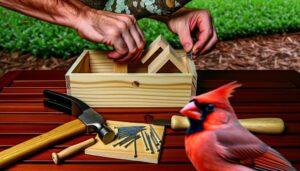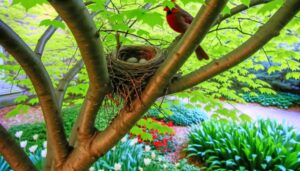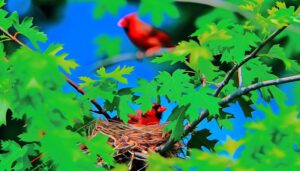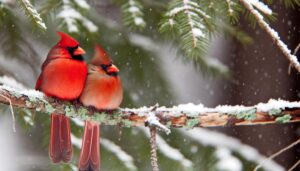5 Tips to Do to Attract Cardinals to Your Garden
To attract cardinals, select sturdy, spacious tube or platform feeders with broad perches and protective roofs. Prioritize sunflower and safflower seeds, incorporating cracked corn in winter.
Provide dense shrubs like dogwood for shelter and strategically position nesting boxes. Guarantee clean, reachable water sources in shaded areas.
Install predator guards and remove ground threats such as cats. Adapt for seasons—provide high-fat seeds in winter and protein-rich insects in spring.
This research-backed method optimizes cardinal visits to your yard, creating the foundation for an incredible bird-watching experience.
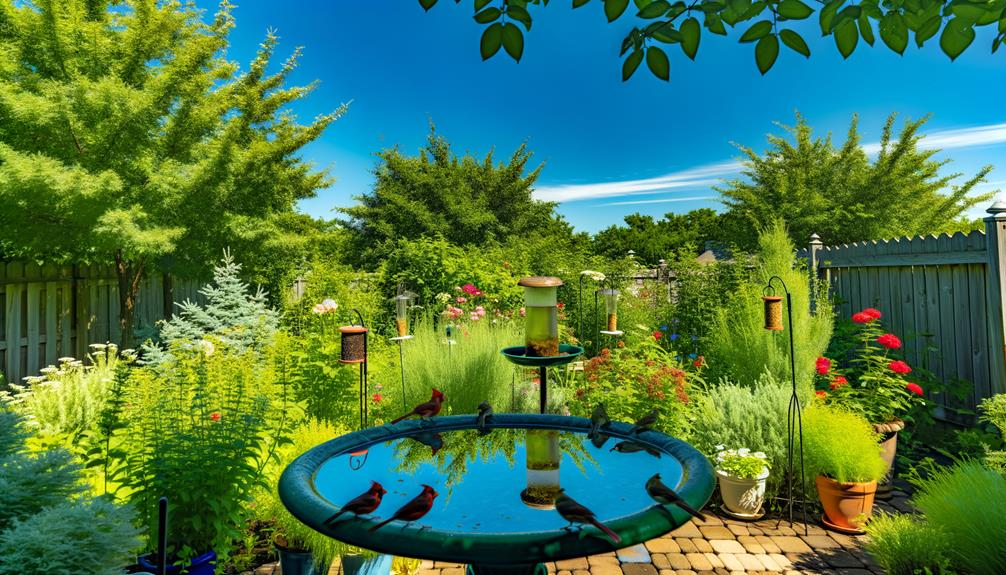
Key Takeaways
- Use sturdy feeders with wide perches or platforms and a protective roof.
- Offer sunflower and safflower seeds, and supplement with cracked corn in winter.
- Plant native shrubs like dogwood and serviceberry to provide dense nesting foliage.
- Ensure a clean, shaded water source at a suitable height.
- Install predator guards and eliminate threats like domestic cats for a safe environment.
Choosing the Right Feeders
Selecting the right feeders is important because cardinals prefer sturdy, large, and well-designed feeders that accommodate their size and feeding habits. You should opt for feeders with a robust construction, as cardinals are medium-sized birds that exert significant pressure on feeding perches.
Tube feeders with wide perches or platform feeders provide sufficient space for cardinals to comfortably land and feed. Observational studies indicate that cardinals favor feeders with a protective roof or cover, which helps shield them from predators and adverse weather. Evidence also shows that placing feeders at least five feet above the ground minimizes the risk of ground predators.
Ultimately, your goal is to create a safe, inviting environment that meets the specific needs of these beautiful birds.
Selecting Cardinal-Friendly Foods
When choosing foods for cardinals, prioritize seeds such as sunflower and safflower, as studies have shown these to be among their preferred dietary selections. Their beaks are specifically adapted for cracking these types of seeds.
To optimize your feeding strategy, consider the following:
- Sunflower Seeds: Both black oil and striped varieties are highly favored, providing essential fats and proteins.
- Safflower Seeds: These seeds are less appealing to squirrels and other birds, ensuring cardinals get their share.
- Cracked Corn: A reliable supplement, especially in winter months, offering necessary carbohydrates.
Research indicates that cardinals are more likely to frequent feeders stocked with these specific seeds. Observations reveal that a diverse yet targeted approach to feeding increases the frequency and duration of cardinal visits.
Providing Adequate Shelter
You can attract cardinals by selecting native plants like dogwood and serviceberry, which provide both shelter and food.
Evidence shows that cardinals prefer dense foliage for nesting, so strategically placing nesting boxes in secluded areas can enhance their habitat.
Studies indicate that these measures notably increase cardinal presence in residential areas.
Native Plant Choices
Cardinals thrive most in environments where native plants like dogwood, serviceberry, and elderberry provide both shelter and food sources. To attract these vibrant birds, focus on integrating native flora into your garden. Native plants are adapted to local conditions, offering ideal habitat and sustenance.
Consider these three key native plant choices:
- Dogwood (Cornus spp.): Offers dense foliage for shelter and berries rich in nutrients.
- Serviceberry (Amelanchier spp.): Provides early-season flowers and summer fruit, attracting insects and cardinals alike.
- Elderberry (Sambucus spp.): Produces clusters of berries and thick branches for nesting.
Nesting Box Placement
Strategically situating nesting boxes at a height of 5 to 15 feet in secluded areas with dense greenery will significantly increase the likelihood of attracting cardinals. Dense foliage provides essential shelter from predators and inclement weather, resembling their natural environment.
Observe cardinal preferences for nesting in shrubs, small trees, or vines. Utilize nesting boxes with dimensions of approximately 6×6 inches and an entrance hole diameter of about 1.5 inches to accommodate their size. Position the boxes facing away from prevailing winds to secure stability and comfort.
Documenting these placements can help improve your strategy. By providing suitable nesting options, you're actively contributing to the preservation of cardinals, improving their reproductive success, and fostering a thriving ecosystem.
Ensuring a Water Source
To attract cardinals effectively, you must guarantee an accessible and clean water source.
Place the bird bath in a shaded area to prevent rapid evaporation and algae growth.
Regularly clean the water to prevent bacterial contamination, as cardinals prefer fresh water for drinking and bathing.
Bird Bath Placement
Securing a dependable water source is crucial, and positioning a bird bath in a shaded area will help uphold water temperature and cleanliness, attracting cardinals and other bird species. Placing the bird bath strategically can notably enhance its effectiveness.
Follow these guidelines:
- Elevation: Position the bird bath at a suitable height to deter ground predators from accessing it.
- Proximity to Cover: Ensure nearby shrubs or trees provide quick escape routes for cardinals if threatened.
- Visibility: Ensure the bird bath is easily seen by flying birds, increasing its usage.
Scientific observations confirm that shaded, accessible, and safe water sources are more frequented by cardinals. By carefully considering placement, you cater to both the birds' needs and your aim of creating a lively habitat.
Clean Water Maintenance
How can you maintain clean water in your bird bath to consistently attract cardinals?
First, make sure you replace the water every two days to prevent stagnation and bacterial growth.
Scrub the bird bath with a solution of one part vinegar to nine parts water weekly to remove algae and debris.
Using a bird bath with a shallow basin and textured surface will aid in easy cleaning and prevent slipping.
During colder months, place a heated bird bath to prevent water from freezing, guaranteeing cardinals have a reliable source year-round.
These practices are essential for maintaining an inviting environment for cardinals, promoting their health and well-being while providing you the joy of serving these beautiful birds.
Creating a Safe Environment
Establishing a predator-free zone is vital for attracting cardinals, as these birds rely on a secure habitat to thrive. You can create a safe environment by implementing the following measures:
- Install predator guards: Utilize baffles and guards on bird feeders and nesting sites to deter predators such as squirrels and raccoons.
- Provide dense foliage: Offer shrubs and trees that provide ample cover, reducing the risk of predation from hawks and other birds of prey.
- Eliminate ground threats: Keep the area free from domestic cats and other ground predators by using fencing or creating designated no-pet zones.
Evidence shows that cardinals are more likely to frequent areas where they feel safe, making these steps essential for their sustained presence and well-being.
Seasonal Tips and Tricks
Understanding the seasonal behaviors and dietary preferences of cardinals can greatly enhance your ability to attract and retain these vibrant birds throughout the year.
In winter, cardinals rely heavily on high-fat seeds like sunflower and safflower to sustain their energy. Position feeders in sheltered areas to protect them from harsh weather.
During spring and summer, they seek protein-rich insects; offering mealworms can be particularly effective. Cardinals nest during these months, so providing dense shrubs and nesting materials like twigs can encourage them to stay.
Autumn sees a shift back to seeds and berries; make sure your garden offers a variety of these foods. By aligning your offerings with their seasonal needs, you'll foster a welcoming environment for cardinals year-round.
Conclusion
To attract cardinals, choose feeders with wide perches, offer sunflower seeds, and provide ample shelter with dense shrubs.
Don't forget a water source, like a birdbath, and make sure the environment is safe from predators.
These birds are like nature's jewels, so by following these steps, you'll create a cardinal haven.
Seasonal adjustments can further improve your success.
Remember, evidence shows that a comprehensive approach leads to higher cardinal visitation rates.
Enjoy your vibrant feathered guests!


